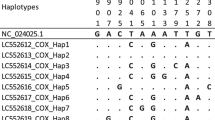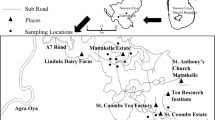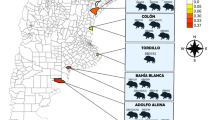Summary
The most common and widespread liver flukes of the genus Fasciola are Fasciola hepatica and F. gigantica. Adults of both species occur in many domestic ruminants and in humans and can cause serious disease. The differential diagnosis of these flukes infection is very important because of their different transmission and epidemiological characteristics. A simple and rapid PCR-restriction fragment length polymorphism (RFLP) assay, using the common restriction enzymes AluI and RsaI, is described to distinguish between both fasciolid species. After the digestion of the mitochondrial cytochrome c oxidase 1 (CO1) PCR product with the restriction enzyme AluI, the RFLP profile obtained from F. hepatica revealed two fragments, whereas F. gigantica was not cut. The RsaI digestion generated two fragments from F. gigantica, whereas it did not cut the PCR product from F. hepatica. Results were confirmed with CO1 sequence analysis of both F. hepatica and F. gigantica. The present study suggests that the PCRRFLP method described here can be used for the proper identification of Fasciola species.
Similar content being viewed by others
References
Adlard, R. D., Barker, S. C., Blair, D., Cribb, T. H. (1993): Comparison of the second internal transcribed spacer (ribososmal DNA) from populations and species of Fasciolidae (Digena). Int. J. Parasit., 23: 423–425
Andrews, S. J. (1999): The life cycle of Fasciola hepatica. In: DALTON, J. P. (Ed.) Fasciolosis. CAB International Publishing, Oxon, UK, 1–29
Balkaya, I., Simsek, S. (2010). Prevalence and economic importance of hydatidosis and fasciolosis in slaughtered cattle in Erzurum province of Turkey. Kafkas Univ. Vet. Fak. Derg. 16: 793–797
Blair, D., Mcmanus, D. P. (1989): Restriction enzyme mapping of ribosomal DNA can distinguish between fasciolid (liver fluke) species. Mol. Biochem. Parasitol. 36: 201–208
Bowles, J., Blair, D., Mcmanus, D. P. (1992): Genetic variants within the genus Echinococcus identified by mitochondrial DNA sequencing. Mol. Biochem. Parasitol. 54: 165–174
Demirci, M., Korkmaz, M., Kaya, S., Kuman, A. (2003): Fascioliasis in eosinophilic patients in the Isparta region of Turkey. Infection, 31: 15–18
Erensoy, A., Kuk, S., Ozden, M. (2009): Genetic identification of Fasciola hepatica by ITS-2 sequence of nuclear ribosomal DNA in Turkey. Parasitol. Res. 105: 407–412
Hashimoto, K., Watanobe, T., Liu, C. X., Init, I., Blair, D., Ohnishi, S., Agatsuma, T. (1997): Mitochondrial DNA and nuclear DNA indicate that the Japanese Fasciola species is F. gigantica. Parasitol. Res. 83: 220–225
Huang, W. Y., He, B., Wang, C. R., Zhu, X. Q. (2004): Characterisation of Fasciola species from Mainland China by ITS-2 ribosomal DNA sequence. Vet. Parasitol. 120: 75–83
Itagaki, T., Tsutsumi, K. (1998): Triploid form of Fasciola in Japan: genetic relationships between Fasciola hepatica and Fasciola gigantica determined by ITS-2 sequence of nuclear rDNA. Int. J. Parasitol. 28: 777–781
Itagaki, T., Kikawa, M., Sakaguchi, K., Shimo, J., Terasaki, K., Shibahara, T., Fukuda, K. (2005): Genetic characterization of parthenogenic Fasciola sp. in Japan on the basis of the sequences of ribosomal and mitochondrial DNA. Parasitology, 131: 679–685
Marcilla, A., Bargues, M. D., Mas-Coma, S. (2002): A PCR-RFLP assay for the distinction between Fasciola hepatica and Fasciola gigantica. Mol. Cel. Prob. 16: 327–333
Mas-coma, S., Bargues, M. D. (1997): Human liver flukes: a review. Res. Rev. Parasitol. 57: 145–218
Mcmanus, D. P., Bowles, J. (1996). Molecular genetic approaches to parasite identification: their value in diagnostic parasitology and systematics. Int. J. Parasitol. 26: 687–704
Sambrook, J., Fritsch, E. F., Maniatis, T. (1989): Detection and Analysis of Proteins Expressed from Cloned Genes. Molecular Cloning. A Laboratory Manual. Cold Spring, Harbor Laboratory press. New York, USA.
Simsek, S., Risvanli, A., Utuk, A. E., Yuksel, M., Saat, N., Koroglu, E. (2007): Evaluation of relationship between repeat breeding and Fasciola hepatica and hydatid cyst infections in cows in Elazig district of eastern Turkey. Res. Vet. Sci. 83: 102–104
Toparlak, M., Tasci, S., Gul, Y. (1989): Liver fluke infections in cattle slaughtered in Van abattoir. Vet. J. Ankara Univ. 36: 419–423
Turhan, O., Korkmaz, M., Saba, R., Kabaaalioglu, A., Inan, D., Mamikoglu, L. (2006). Seroepidemiology of fascioliasis in the Antalya region and uselessness of eosinophil count as a surrogate marker and portable ultrasonography for epidemiological surveillance. Infez Med. 14: 208–212
Yilmaz, H., Godekmerdan, A. (2004). Human fasciolosis in Van province, Turkey. Acta Trop. 92: 161–162
Author information
Authors and Affiliations
Corresponding author
About this article
Cite this article
Simsek, S., Utuk, A.E. & Balkaya, I. Molecular differentiation of Turkey cattle isolates of Fasciola hepatica and Fasciola gigantica . Helminthologia 48, 3–7 (2011). https://doi.org/10.2478/s11687-011-0001-y
Received:
Accepted:
Published:
Issue Date:
DOI: https://doi.org/10.2478/s11687-011-0001-y




